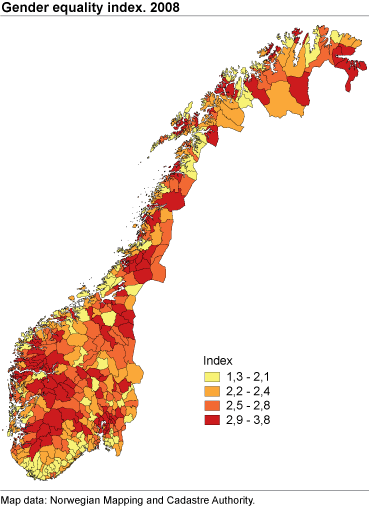Content
Published:
This is an archived release.
Tromsø is Norway's most gender equal municipality
The gender equality index for 2008 reveals considerable differences between Norwegian municipalities. Women and men in Tromsø are still most equal, as the index has showed for the last three years. On county level, Vest-Agder and Aust-Agder have the lowest score for the third year in a row.
|
The municipalities can achieve a maximum score of 4 and a minimum score of 1.This index is relative: The fact that a municipality has a 4 on income, for instance, does not mean that women and men have the same income, only that the municipality is placed in the highest quartile. |
With a score of 3.8 points, Tromsø has the highest score, closely followed by Overhalla in Nord-Trøndelag and Sør-Varanger in Finmark. At the bottom of the ranking is Farsund (Vest-Agder) closely beaten by Selje (Sogn og Fjordane) and Bjugn (Sør-Trøndelag).
Women in the South are still least equal
Women and men in the southern-most counties are least equal. Vest-Agder is the least equal county, followed by Aust-Agder. The municipalities in Vest-Agder have a particularly low percentage of female municipal council members and women have lower income than men compared with withother counties. Aust-Agder has the lowest score when it comes to women’s participation in the labour force and Akershus county has the highest score. Almost all municipalities in Akershus are above the national average.
Norway’s five largest cities, Oslo, Bergen, Stavanger, Trondheim and Kristiansand all have scores above the national average of 2.5 points.
Many ways to describe gender equalityThe gender equality index combines various indicators of gender equality to show the extent to which women and men participate in politics, education and working life. The indicators are: Kindergarten coverage for children aged 1-5 (2007) Number of women per 100 men aged 20-39 (2007) Education levels for women and men (2007) Labour force participation for women and men (2007) Income for women and men (2007) Percentage of female municipal council members (2007) The tables contain more detailed information and enable users to compare counties and municipalities by individual indicators and as a total. "About the statistics" contains information on how the index is estimated. |
Tables:
- Table 1 Gender Equality Index for Norwegian municipalities, sorted by county. 2008
- Table 2 Gender Equality Index for Norwegian municipalities, by ranking. 2008
- Table 3 Gender Equality Index for Norwegian municipalities, ranked by county. 2008
- Table 4 Gender Equality Index for Norwegian municipalities, data. 2008
Additional information
The indicators of gender equality in municipalities has been published every year since 2008. The indicators are based on available statistics from registers, and measure gender equality in all municipalities and counties, as well as average for the whole country.

